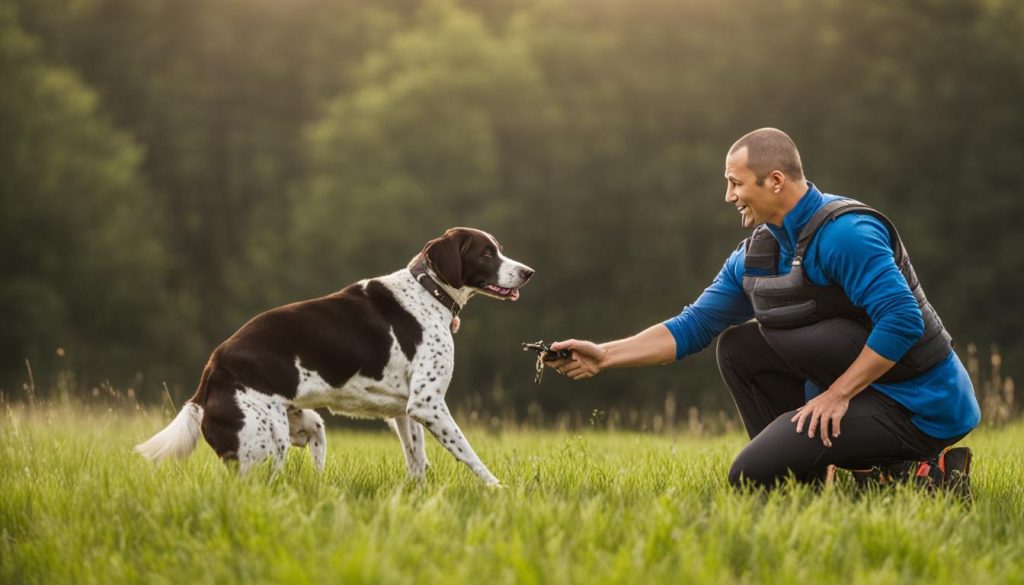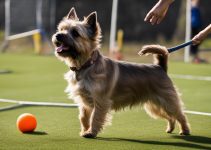As a dog owner, I understand the importance of German Shorthaired Pointer Training. These energetic and intelligent dogs require proper training to become well-behaved companions and skilled hunting partners. In this article, I will share with you some effective tips for training your GSP, from puppyhood to advanced training techniques.
When bringing a GSP puppy into your home, it’s essential to start training early. They are highly receptive to training, making it easier to teach them obedience and hunting skills. By following these tips, you can develop a strong bond with your GSP and ensure they become disciplined and happy dogs.
Whether you’re a novice owner or an experienced trainer, these tips will provide you with the guidance you need for an effective German Shorthaired Pointer training.
German Shorthaired Pointer Training
- Start training your GSP puppy from an early age to establish good behaviors.
- Focus on obedience training, socialization, and basic commands.
- Introduce your GSP to various environments and situations to prevent fear and anxiety.
- Consider enrolling your GSP in puppy classes to receive professional guidance.
- Use positive reinforcement and consistency while training your GSP.
Key Milestones for Training Your GSP: 8-9 Weeks
Welcome to the exciting journey of training your German Shorthaired Pointer (GSP) puppy! At around 8-9 weeks, this is the perfect time to set the foundation for a well-rounded and obedient companion. To ensure a successful German Shorthaired Pointer training experience, focus on the following key milestones:
- Socialization: One of the most important aspects of GSP puppy training is socializing them with other people and animals. Expose your puppy to different environments, situations, and individuals to prevent fear and anxiety later in life.
- Basic Commands: Start teaching your GSP puppy basic commands such as name recognition, sit, down, leave it, and going into the kennel or crate. These commands form the foundation of obedience training and help establish communication with your furry friend.
- Grooming: Introduce your GSP puppy to daily grooming routines early on. Start with gentle brushing and gradually introduce nail trimming. This allows your puppy to get accustomed to grooming activities and ensures they grow up to be comfortable with regular grooming sessions.
- Potty Training: Begin potty training during this period. Establish a consistent routine, take your puppy outside frequently, and reward them for eliminating in the appropriate location. Be patient and consistent, as it may take some time for your GSP puppy to fully grasp the concept.
- Leash Training: Start introducing your GSP puppy to leash training. Use a lightweight leash and a comfortable collar or harness. Begin with short walks in familiar surroundings, gradually increasing the duration and introducing new environments. Remember to reward good behavior with treats and praise.
By focusing on these key milestones during the 8-9-week period, you can lay a solid foundation for your German Shorthaired Pointer training journey. Remember to be patient, consistent, and always use positive reinforcement techniques. With time and dedication, your GSP will develop into a well-behaved and happy canine companion.
Key Milestones for Training Your GSP: 12-14 Weeks
At 12-14 weeks, additional milestones in GSP training can be achieved. Socializing your GSP puppy with other dogs becomes important after they have received their second shots. This helps them develop positive behaviors and reactions towards other canines.
Another exciting milestone during this period is when your GSP puppy starts sleeping through the night without needing to go out for potty breaks. This allows for more uninterrupted rest for both you and your puppy.

This phase of training is crucial for your GSP’s development. Socializing with other dogs enables them to learn proper doggy etiquette and helps prevent behavioral issues in the future. It is recommended to expose your puppy to different dog breeds, sizes, and temperaments to make them comfortable in various social situations.
Celebrate the achievement of your GSP sleeping through the night without interruptions. This indicates their growing ability to control their bladder and provides you with well-deserved restful nights.
Continue focusing on basic obedience training during this stage, reinforcing commands such as sit, stay, and come. Consistency and positive reinforcement remain key in these training sessions.
Remember to establish a balance between training and playtime, ensuring your GSP receives adequate mental stimulation and physical exercise to channel their energy in a positive way.
Key Milestones for Training Your GSP: 4 Months
When your German Shorthaired Pointer (GSP) reaches around 4 months, they will enter the teething stage. This is an important milestone in their training journey, as their chewing behavior may intensify. To prevent damage to your furniture, it is essential to redirect their chewing towards appropriate toys.

One option is to provide your GSP with chew toys specifically designed for teething puppies, such as Nylabones or Kongs. These toys help soothe their sore gums and redirect their chewing instincts. Make sure to choose sturdy toys that can withstand persistent chewing.
Aside from addressing teething behavior, 4 months is also an ideal time to enroll your GSP in puppy classes. These classes not only provide basic obedience training but also allow your GSP to socialize with other dogs. Puppy classes tailored to their age and growth stage will help them develop crucial social skills and build confidence.
During puppy classes, professional trainers will guide you in teaching your GSP basic commands, such as sit, stay, and come. They will also introduce your pup to leash walking and help you establish proper leadership. The structured environment of puppy classes promotes positive reinforcement and consistent training techniques.
Remember, teaching your GSP at this stage sets the foundation for their future behavior and skills. By providing appropriate chew toys and enrolling them in puppy classes, you can ensure their overall development and readiness for more advanced training in the future.
Conclusion: Unleashing Your GSP’s Hunting Potential
German Shorthaired Pointer training to become a skilled hunting companion requires a combination of various training techniques. Alongside crate training and basic obedience, exposing your GSP to birds is crucial for honing their hunting skills. Gradually introducing them to the sound of guns and gunfire during training is essential to prepare them for the real hunting experience.
However, hunting skills alone are not enough. It is equally important to focus on basic commands, socialization, leash training, and exercise. By providing your GSP with proper socialization and exposure to different situations, you ensure they become well-adjusted and confident in various environments.
Positive reinforcement is the key to successful German Shorthaired Pointer training. Rewarding desired behaviors with treats, praise, and affection reinforces their training and encourages them to repeat those behaviors. Consistency is also crucial, as GSPs thrive on routine and clear expectations.
Remember to keep German Shorthaired Pointer training sessions short and engaging to cater to their energetic nature. Both mental and physical exercise are important for GSPs, as they are an active breed that requires ample stimulation to remain happy and content.
By implementing these German Shorthaired Pointer training tips, you can unleash the hunting potential of your GSP while developing a strong bond with them. With the right guidance, patience, and dedication, your German Shorthaired Pointer will become a skilled hunting partner and a cherished member of your family.
FAQ
When is the best time to welcome a GSP puppy into my home?
It is recommended to welcome a GSP puppy into your home at around 8-9 weeks of age.
What should I focus on during the initial training period?
During the initial training period, focus on socializing your puppy, teaching basic commands, introducing grooming routines, potty training, and leash training.
What milestones can be achieved when training a GSP at 12-14 weeks?
At 12-14 weeks, important milestones include socializing your GSP with other dogs and the puppy starting to sleep through the night without needing potty breaks.
How can I manage teething behavior in my 4-month-old GSP?
To manage teething behavior, redirect your GSP’s chewing towards appropriate toys, such as Nylabones or Kongs.
Should I enroll my GSP in puppy classes?
Yes, enrolling your GSP in puppy classes is recommended to provide them with basic obedience training and opportunities to socialize with other dogs.
How can I train my GSP to become a skilled hunting companion?
Training a GSP for hunting involves crate training, basic obedience, exposure to birds, and gradually introducing them to the sound of guns and gunfire during training.
What are the key factors to ensure successful GSP training?
Consistency, positive reinforcement, short training sessions, and providing physical and mental stimulation through exercise and socialization are key factors for successful GSP training.






